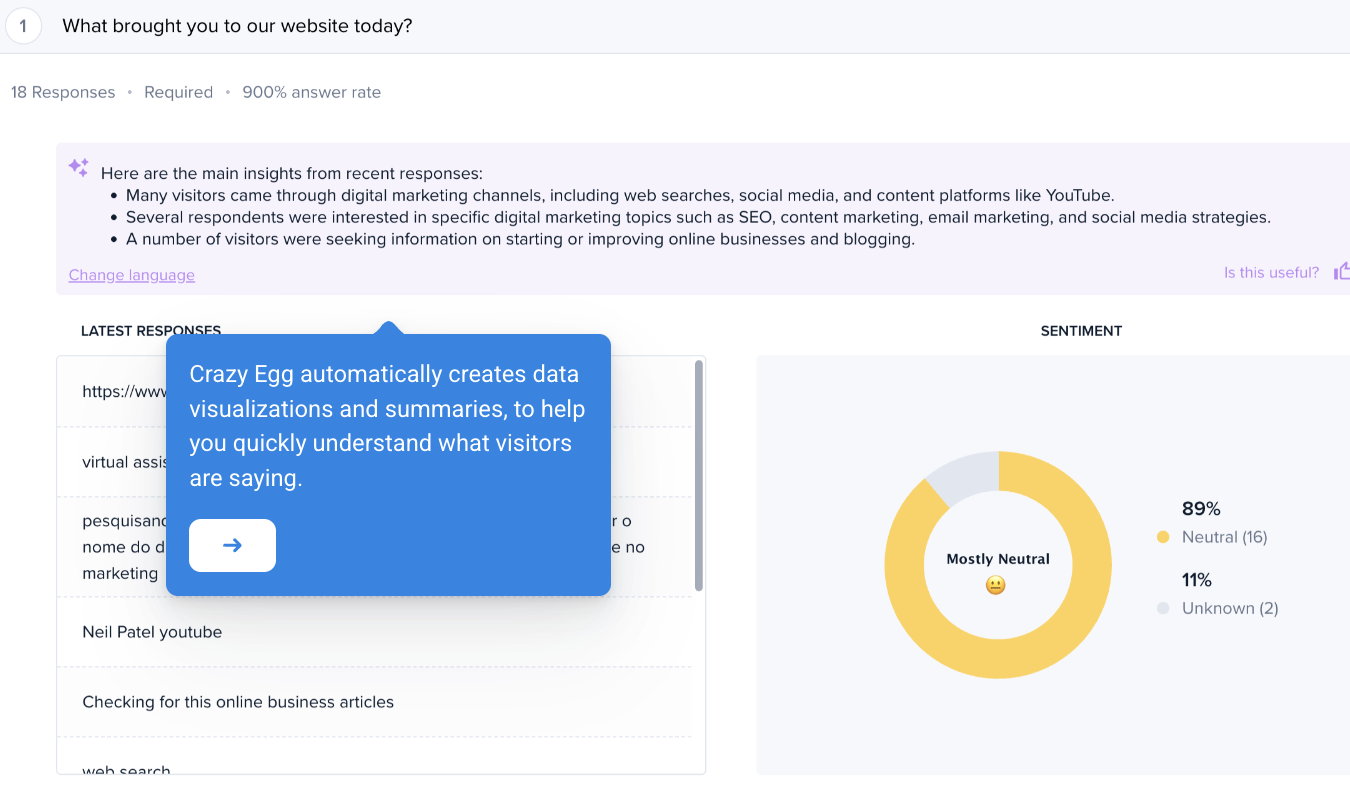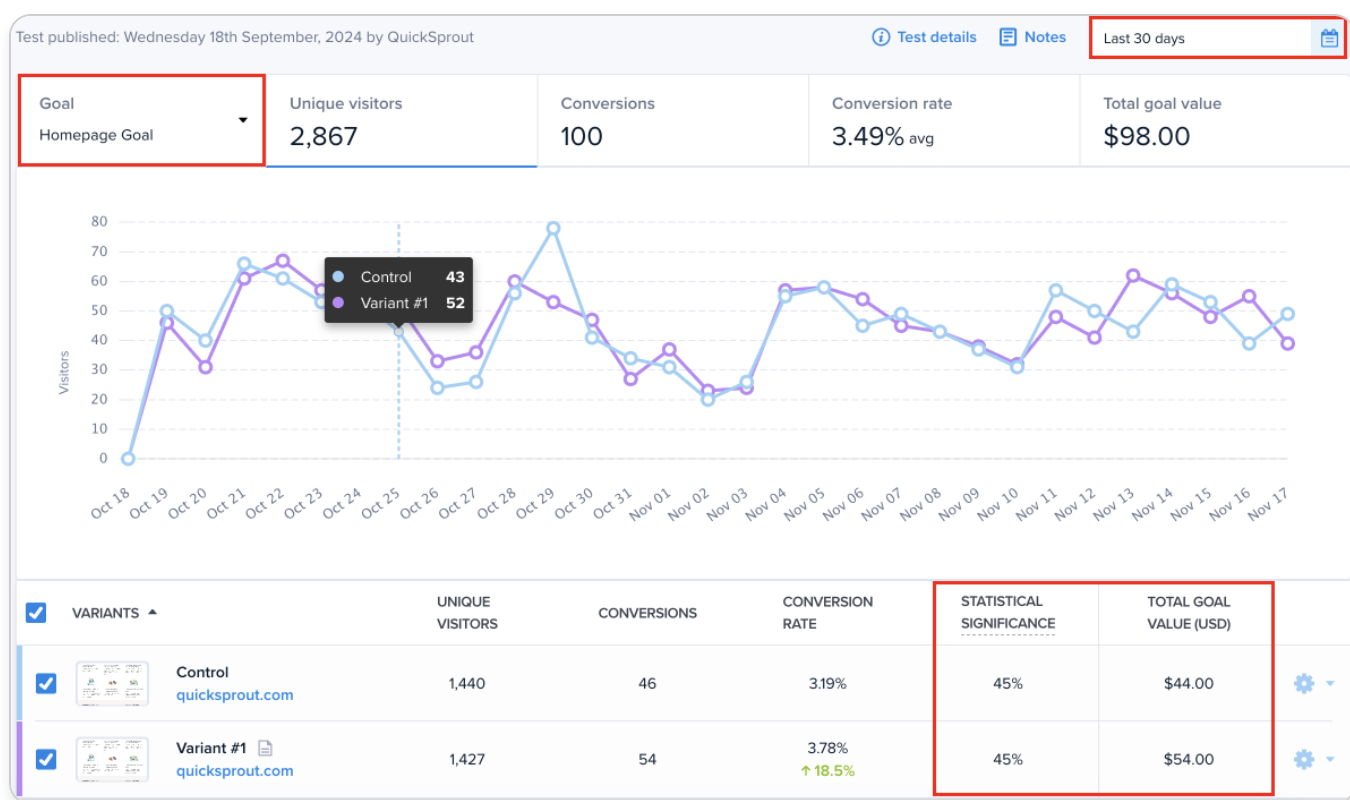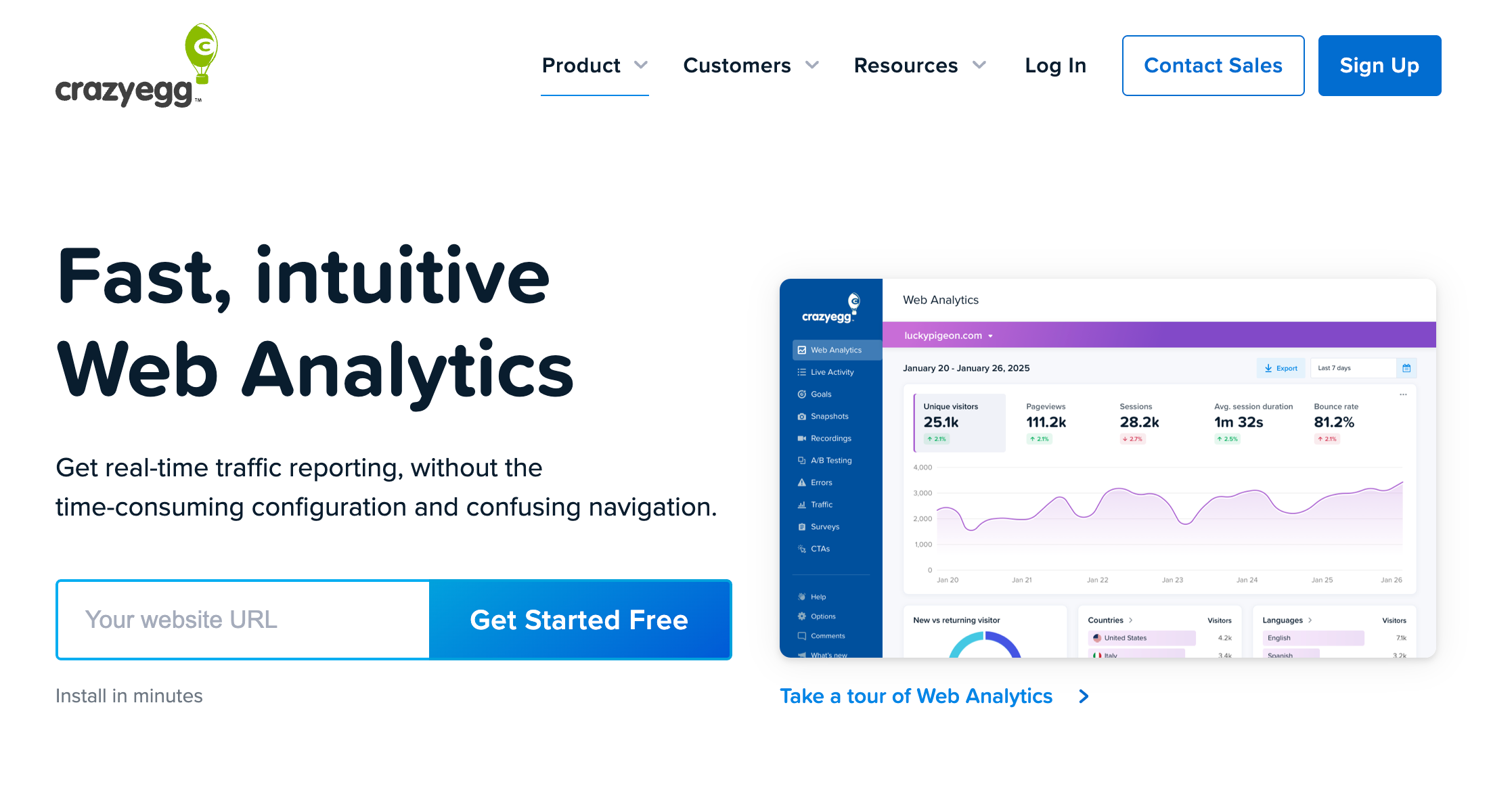Looking for the best alternatives to PostHog, an open-source web and product analytics tool? We recommend Crazy Egg, Fullstory, or Amplitude as the top choices.
Read on to find out why we picked these analytics tools as the best PostHog alternatives.
My Personal Top 3 Alternatives to PostHog
Need a quick overview? Here are my top three PostHog alternatives and a snapshot of each.
| Best free web analytics | Best for enterprise user tracking | Best analytics for the user journey |
|---|---|---|
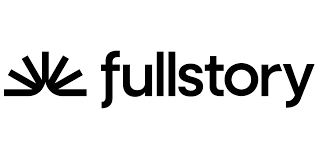 |  | |
| Crazy Egg Pricing: $29–$499/mo, web analytics is free What I like: Five heatmap types, session recordings, built-in A/B tests, and surveys give a full view of user behavior—no dev work needed. | FullStory Pricing: Enterprise What I like: Unified analytics for sites, apps, and internal tools, plus powerful session replay and conversion tracking for large teams. | Amplitude Pricing: From $49/mo What I like: Rich journey maps, behavioral cohorts, A/B testing, and AI insights connect product usage directly to business results. |
How I Chose These PostHog Alternatives
Picking a PostHog alternative involves more than just looking at which tool has the most beautiful charts or the lowest price.
Here’s what I considered when combing through all the possibilities:
- Behavior tracking. How well the tool captures what users are doing on your site or app—it should be automatic and accurate without constant upkeep from a developer team.
- Testing and experimentation. Whether you can easily run experiments (like A/B tests) and safely roll out new features with tools like feature flags.
- UX insights. Tools that let you see what’s happening on your site or app via heatmaps, session recordings, journey maps, and other visually appealing formats.
- Surveys. Can you create and deploy surveys in your app or website—and summarize the responses quickly with AI?
- Integrations. Does the tool easily integrate with industry favorites, like Google Analytics 4, Segment, or your data warehouse? A strong PostHog alternative should naturally fit into your existing set of tools.
- Performance at scale. How well does the PostHog alternative keep up with fluctuations in users—especially large, upward fluctuations?
- Data ownership and privacy. One of PostHog’s biggest selling points is how much control it gives you over your data. The best alternatives should offer that same sense of security by letting you choose where to store your data, who can access it, and how it’s used.
Ready to see which PostHog alternatives made the cut? Let’s begin.
1. Crazy Egg
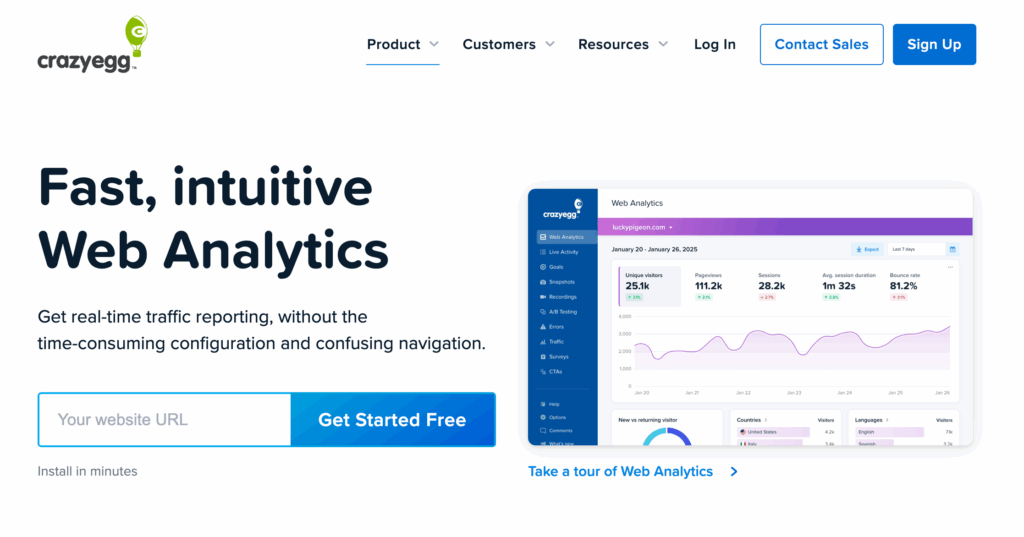
Crazy Egg is a website analytics tool that’s been around since 2005—and it’s been innovating to keep up with the times ever since.
What I like:
- Strong visual behavior tracking. Crazy Egg offers five types of heatmaps: click, scroll, confetti, overlay, and list, each of which presents data in a uniquely valuable format. Click maps, for example, show where visitors are clicking the most on your page. A scroll map shows how far down the page your web visitors scroll. Crazy Egg’s impressive range of maps gives you a full picture of what’s going on on your site.
- Session recordings. This feature is a core part of Crazy Egg’s offerings, and it allows you to watch actual user sessions and easily spot areas that confuse or frustrate your visitors.
- Built-in A/B testing. Crazy Egg lets you create and run simple A/B tests from right within the platform. You don’t need any extra tools or external integrations to test your headlines, images, and layouts. After each test, you get a visual representation of the results for easy analysis.
- Survey tools. Crazy Egg’s on-page survey creation tool makes it easy for you to capture feedback from web visitors while they’re actively browsing. This means any concerns or praises will be top of mind, which translates into high-quality feedback. With Crazy Egg’s new AI summary tool for surveys, you can quickly identify trends in the responses and get suggestions for improvement.
- Clear UX focus. While PostHog is engineered for…well, engineers (and data scientists), Crazy Egg is more accessible to non-engineers like marketers, designers, and growth teams. You don’t need a whole dev degree just to interpret and share the insights you gather. Plus, each insight is presented in a color-coded, intuitive visual. This makes it easy for your team to share it with anyone, including non-technical stakeholders.
- Variety of integrations. Crazy Egg integrates with Google Analytics 4, Shopify, Kameleoon, Segment, and Zapier, so you can pretty much connect with any tool in your stack.
What could use improving:
- Limited to web analytics. If you need product analytics for an app, you’ll need to use another tool, as Crazy Egg only offers analytics for web-based products or companies.
Who should use it:
- Marketers, designers, and product managers who want a fast and highly visual way to understand how users interact with their site—all without needing a master’s degree in computer engineering. Crazy Egg is an affordable choice for businesses of all sizes—paid plans begin at $29 a month. Crazy Egg also has a free plan that includes their web analytics tool.
2. Fullstory
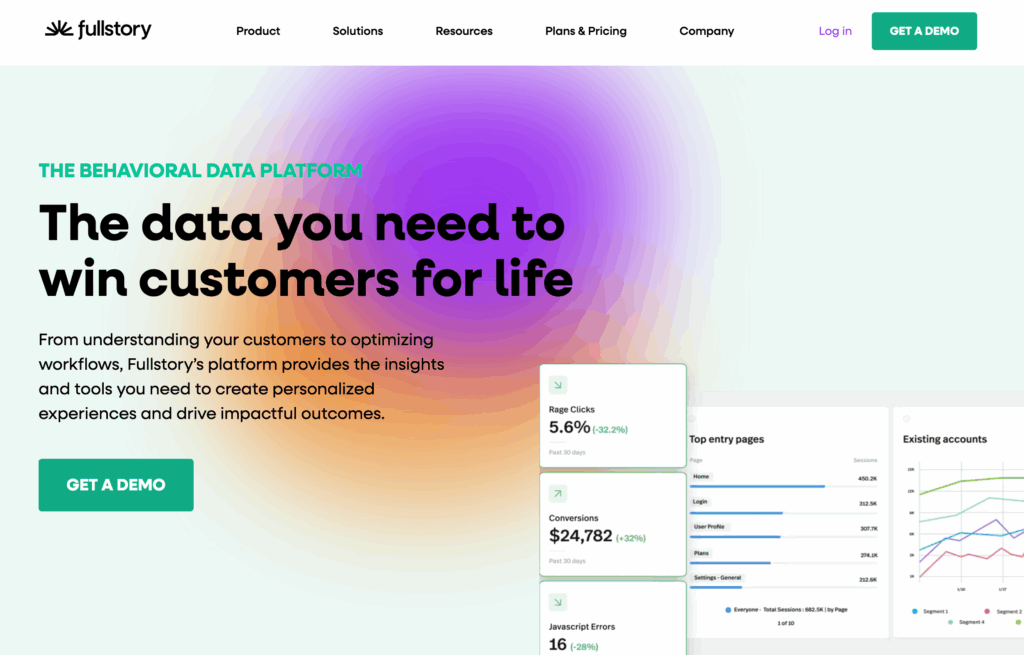
Fullstory is a behavior analytics platform designed to work on every digital interface your customers—and employees—touch.
What I like:
- Analytics for every interface. Fullstory is a smart name for this tool because it really does capture the full story of a larger organization’s digital interfaces. Here’s what I mean. Fullstory offers three analytics products: one for websites and apps (Analytics), one for your workplace’s internal app (Workforce), and one for your integrated tech stack and data warehouse (Anywhere). It leaves no digital surface unmonitored, which is big for mid- to large-sized brands with more digital interfaces than they can count on one hand.
- Complete session replay and heatmap features. Users get a full suite of tools for session insights, including live session viewing, heatmaps (with click and scroll views), session replay, and, on higher plan tiers, conversion maps and AI summaries.
- Full product analytics for SaaS tools and apps. Mobile analytics are available as an add-on to any plan. Users get customizable dashboards, funnels, user segmentation, trend tracking, and a segment health checking tool. Higher plan tiers get you user journey mapping and conversion analysis features.
- Workplace app analytics. This feature is something many PostHog alternatives don’t offer, and it’s a big part of why I included Fullstory on this list. If you need a single analytics solution to monitor both your employee- and customer-facing apps, Fullstory’s got you covered. For your workplace app, the focus is less on conversions and more on troubleshooting. To this end, Fullstory offers co-browsing, highly customizable search filters to troubleshoot any issue, and segment alerts to notify you of an issue in the app even when you’re not logged in.
- Integration analytics. Fullstory doesn’t just offer dozens of popular integrations, from Google Analytics 4 and BigQuery to Slack and Shopify. It also offers data tracking and analysis tools to help you optimize the connection between your integrations and your core product.
What could use improving:
- No built-in A/B testing or survey tools. While Fullstory integrates with tools for A/B testing and surveys, it does not offer these features natively. This is a symptom of one of Fullstory’s main drawbacks: it offers so many products for so many digital interfaces that the breadth of its offerings is more of a focus than their depth.
- Unclear pricing and multitudinous add-ons. There’s no good way to gauge how much Fullstory will cost you to use. To get pricing, you have to request a demo. There is a layout of plans, but no pricing attached to them, and the overwhelming number of add-ons makes the whole plan setup harder to decipher. Basically, when I look at the pricing and plans page, I see a lot of dollar signs and my wallet starts to get achy.
Who should use it:
- Fullstory is best for enterprise brands with deep pockets and multiple digital platforms to monitor across both customers and employees. To request more information on pricing, check out the Fullstory Plans page.
3. Amplitude
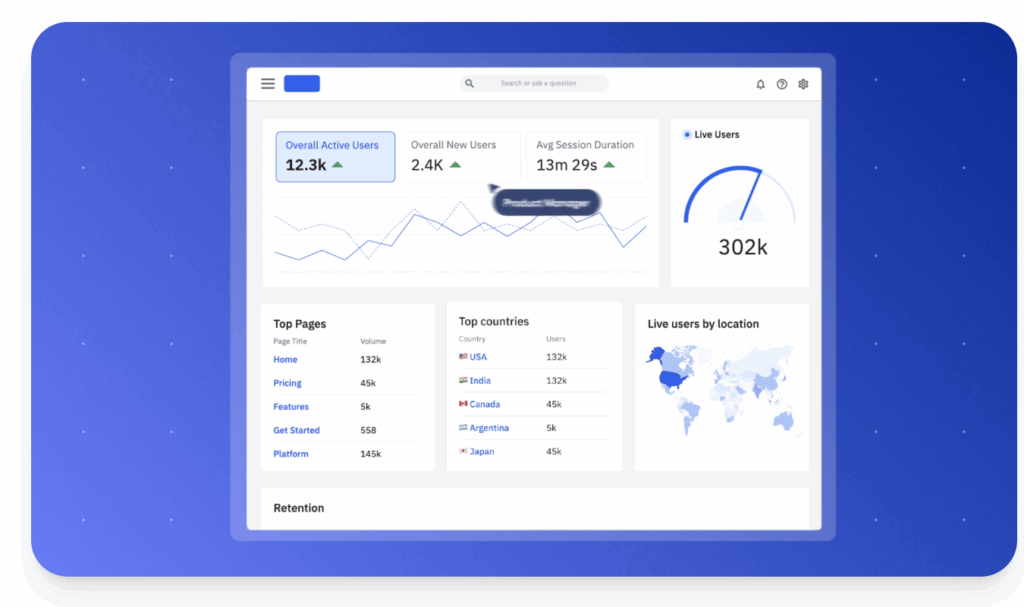
Amplitude is a powerful product analytics platform with a deep focus on mapping the user journey.
What I like:
- Advanced journey and path analysis. Amplitude offers visualization tools to help you map every single route users take through your product, which is one of my favorite things about it. These visualization tools make data easier to absorb and work with at the user level. It also means you can more easily spot behavior patterns or bottlenecks you wouldn’t otherwise notice. Plus, you can tie user journeys directly to important business metrics, like conversion or revenue.
- Behavioral cohorts. In keeping with its focus on the user journey, Amplitude allows you to build custom cohorts of users based on their actual actions. For instance, you can track all the users who viewed a product but didn’t purchase anything as one cohort. This makes analysis and retargeting easier than if you had to study and optimize for each person individually.
- Experiment tracking. Amplitude offers A/B testing for everything from website layout to product updates. The performance is tracked and displayed with all your other analytics. This makes it easier to measure whether your newest features and updates are truly driving the results you want.
- Surveys and AI-powered insights. Along with a dedicated survey creation and collection tool, this PostHog alternative offes Amplitude AI, a feature that looks through your qualitative and quantitative data and extracts any anomalies, trends, and opportunities for improvement. No more manual combing through every single survey result or data point.
- Lots of integrations. Amplitude connects natively with tools like Segment, Snowflake, Braze, and Hubspot. (There’s no Zapier connection, though, which is a downside.)
- Easy collaboration. I like that Amplitude offers features like shareable dashboards, notebooks, and annotations, which make it easy for teams to work together and communicate straight from the data displays.
What could use improving:
- Learning curve and pricing. Amplitude can be intimidating for smaller teams, mostly because its depth and flexibility come with a steep learning curve. The pricing can also get high when you start scaling up event volume or adding features like Experiment (which, regrettably, is only included on higher plan tiers. Amplitude alternatives like Crazy Egg give it to you from the jump).
Who should use it:
- Mid-sized or enterprise teams that want a deep understanding of how each user engages with their product—and want to connect analytics directly to measurable business outcomes. Paid plans begin at $49 a month.
4. Mixpanel

Mixpanel is a product analytics platform for both apps and websites that helps teams track user actions and behavior.
What I like:
- Strong event-based analytics. Like any good analytics tool, Mixpanel’s goal is to help you understand what users actually do when they’re inside your product or browsing your website. What I appreciate about Mixpanel is its strong focus on customizing events—and choosing which ones to track. You can track many events automatically or create custom events to capture the behaviors that matter the most to your business. This might be completing onboarding, for instance, or upgrading to a higher plan tier.
- Custom dashboards. Mixpanel offers highly customizable dashboards that let you showcase data by behavior pattern, cohort, and segment. Then, you can quickly share those reports with your colleagues.
- Funnels. Mixpanel offers a strong focus on funnels, which is something I’ve always appreciated about it. You can build funnels based on the actions users take throughout your app or website. Track drop-offs through any of your multi-step processes (like onboarding or checkout). See when and how customers come back with tools that track retention, with visual reports to boot.
- Strong integrations. Mixpanel connects with major platforms like Segment and data warehouses, plus HubSpot and CRMs.
- Native experimentation and feature flags. Mixpanel now offers an Experiments report that analyzes the performance of A/B test variants. It also now offers a feature flag tool that lets you roll out new features slowly and carefully, analyzing the results at every step.
- Seamless performance at scale. Mixpanel is built specifically to handle large datasets, so it can process millions of events without slowing down. This makes it particularly ideal for apps or sites with a high volume of visitors.
- Clean interface for product teams. Like Crazy Egg, Mixpanel offers visually appealing, interactive charts and an intuitive UI. This makes it easy for non-techy teams to work with the data.
What could use improving:
- Event-tracking requires careful planning. If you don’t tag key actions from the start, you might lose visibility down the road. In other words, you might have gaps in your data for the exact behaviors you’re trying to track. Part of Mixpanel’s power is in how precisely you can define events. So, having a clear tracking plan upfront will save you a lot of reworking and frustration later on.
- High learning curve (and pricing). Mixpanel is designed for enterprise amounts of traffic, which means it’s got a lot of features. These can be difficult to set up and deploy, especially if you’re a smaller organization with fewer resources. (Aka, a small or one-person marketing team trying to figure the whole thing out alone.)
Who should use it:
- Product-led SaaS, mobile, and web teams that want detailed behavior analytics and feature flagging, and who have the resources to work through Mixpanel’s setup. Mixpanel’s paid plans begin at about $24 a month and rise quickly as you scale. (For more info, see our full Mixpanel review.)
What’s the Best PostHog Alternative?
If you’re looking for a web analytics solution that’s affordable, visually appealing, and upfront about pricing, Crazy Egg is the best PostHog alternative for you.
For larger teams that are willing to sacrifice features like surveys and experimentation in favor of cross-platform analytics, Fullstory is ideal.
And if you want to understand the user journey on both mobile and web interfaces, Amplitude will do the trick well, and Mixpanel is a solid option for visualizing funnels. (Want a closer comparison of these last two? Check out our post comparing Mixpanel vs. Amplitude.



